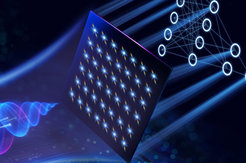Capturing ultra-intense laser pulses in a single shot
A novel single-shot diagnostic technique allows scientists to measure the full structure of ultra-intense laser pulses in a single measurement.

Ultra-intense lasers can accelerate electrons to near-light speeds within a single oscillation of the electric field, making them a powerful tool for studying extreme physics. However, their rapid fluctuations and complex structure make real-time measurements of their properties challenging. Until now, existing techniques typically required hundreds of laser shots to assemble a complete picture, limiting our ability to capture the dynamic nature of these extreme light pulses.
Researchers at the Centre for Advanced Laser Application (CALA) - including IMPRS-APS scientists Jannik Esslinger, Jakob Schröder, Stefan Karsch and Andreas Döpp - in close collaboration with scientists at the University of Oxford have now unveiled a pioneering method for capturing the full structure of ultra-intense laser pulses in a single measurement. The novel single-shot diagnostic technique, named RAVEN (Real-time Acquisition of Vectorial Electromagnetic Near-fields), allows scientists to measure the full shape, timing, and alignment of individual ultra-intense laser pulses with high precision. The results have been published in Nature Photonics.
Having a complete picture of the laser pulse’s properties could revolutionise performance gains in many areas. For example, it could enable scientists to fine-tune laser systems in real-time and bridge the gap between experimental reality and theoretical models, providing better data for computer models and AI-powered simulations.
The method works by splitting the laser beam into two parts. One of these is used to measure how the laser’s wavelength changes over time. The other part passes through a birefringent material, which separates light with different polarisation states. A microlens array – a grid of tiny lenses – then records how the laser pulse’s wavefront is structured. The information is recorded by a specialised optical sensor, which captures it in a single image from which a computer program reconstructs the full structure of the laser pulse.
“The ability the make quantitative statements about individual laser pulses is a game changer,” says Andreas Döpp, who led the development of RAVEN as part of his Emmy Noether research group. “When I initiated this research four years ago, it was motivated by “lucky shots”: exceptional outcomes of experiments that we could not explain but for chance. Now we can exactly know the field structure driving interaction and understand why certain shots are better than others.”
The technique was successfully tested on the ATLAS-3000 petawatt-class laser at CALA, where it revealed small distortions and wave shifts in the laser pulse that were previously impossible to measure in real-time, allowing the research team to fine-tune the instrument. These distortions, known as spatio-temporal couplings, can significantly affect the performance of high-intensity laser experiments.
By providing real-time feedback, RAVEN allows for immediate adjustments, improving the accuracy and efficiency of experiments in plasma physics, particle acceleration, and high-energy density science. It also results in significant time savings, since multiple shots are not required to fully characterise the laser pulse’s properties. The technique also provides a potential new route to realise inertial fusion energy devices in the laboratory – a key gateway step towards generating fusion energy at a scale sufficient to power societies.
Original Publication:
S. Howard, J. Esslinger, N. Weiße, J. Schröder, C. Eberle, R. H. W. Wang, S. Karsch, P. Norreys, A. Döpp
Single-Shot Spatio-Temporal Vector Field Measurements of Petawatt Laser Pulses
Nature Photonics (2025)
doi.org/10.1038/s41566-025-01698-x
